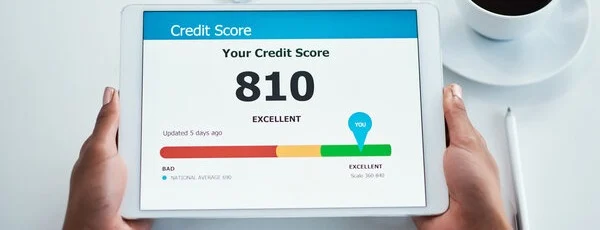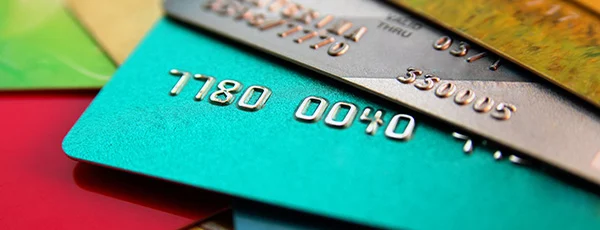Why is My Credit Score Different on Different Sites?

UpdatedJun 15, 2025
- Your credit score can vary for several reasons, including different scoring formulas.
- Credit scores are meant to provide insight into your borrowing history.
- Understanding why your credit score is different on different sites can help you learn how credit works.
When you check your credit score online, you may be surprised to find that your score isn't the same across all websites. This can leave you wondering: Why is my credit score different on different sites?
Your credit score is determined by several factors, and by different formulas. If you’ve paid your bills on time and not used too much credit, your score will usually be very high. If you've been late or gotten in over your head, you may have a lower credit score. But you can improve it after taking steps such as getting debt relief, and paying off what you owe.
This guide will help you understand why there's so much variation in scores, and how this could impact your finances.
This article contains general information for educational use. Freedom Debt Relief isn't a credit repair organization and doesn't provide, or offer, services or advice to repair, modify, or improve your credit
Why Is My Credit Score Different Across Sites? A Quick Explanation
Your credit score varies because:
Scores change. Your credit history is updated regularly, so your score can change often.
Credit reports differ. Not all creditors report to all credit bureaus.
Score models vary. FICO® and VantageScore® use different formulas.
Scores scores. Scores are tailored to different loan types.
Errors. Mistakes in credit reports can impact scores.
Top 5 Reasons Credit Scores Are Different
Why is my credit score different on different sites? This phenomenon can be chalked up to a combination of factors. Here are a few of the reasons you might get different results when you look up your credit score in different places.
#1: Credit scores change over time
Each time you check your credit score, that score is a snapshot of your history with credit accounts. Since the information on your credit report changes when creditors send in new data, your score can (and does) change regularly.
So how often do credit scores update? Typically, at least monthly, but they may change much more often if you use a variety of financial products. It depends on how often your creditors report to credit bureaus, and on what days they report.
Here's how different actions could affect your scores.
Opening a new credit card could trigger an inquiry, which can reduce your credit score.
Adding a different type of debt, such as adding a loan when you've only had credit cards, could increase your score.
Charging too much on one of your cards could increase your credit utilization, causing your score to drop.
Paying off a credit card balance could improve your credit utilization and boost your score.
It's also worth noting that there are multiple factors that impact how much these actions affect your score. For example:
The passage of time makes a difference in how inquiries affect your credit. Inquiries over one year old don't count against your credit score.
Having older accounts can have a positive impact.
Your credit scores can change when information falls off your credit report. Most negative information can stay on your credit report for seven years (some, such as bankruptcy, may stay longer).
Disputing credit report errors could improve your score if the error is corrected or removed.
Frequent changes to your credit score can be a little frustrating if you're trying to pin down your score to apply for a loan. But it's a good reminder that the way you manage credit and debt can influence your score in the short and long term.
Pro tip: Checking your own credit scores won't affect it.
#2: The credit bureaus collect different information
Credit bureaus collect information about your borrowing behavior and use this information to calculate your credit scores. So, if you're wondering “why is my credit score different on different sites,” it's because not every credit bureau gets all of the same information. Their information comes from your creditors and from public records.
Some lenders report credit accounts to all three credit bureaus, but others report to just one or two. And it's possible that a lender may not report to the credit bureaus at all, so those accounts never get factored into your score calculations.
Whether a lender has reported your information to a particular bureau can make a big difference in how your scores work out. If you've made every payment to your car loan on time but your lender only reports to one credit bureau, your positive payment history won't count in your score calculations with the other two.
#3: There are different credit scoring models
Credit scores are calculated using different formulas (the credit bureaus call them models). The two most popular models are FICO and VantageScore. The models consider a combination of factors to determine where you fall on the credit score range. While they are similar, there are also important variations in how they use the factors.
What are FICO Scores?
FICO is the most widely used credit scoring model, and FICO scores range from 300 to 850 (the highest credit score possible). This model was developed by the Fair Isaac Corporation and calculates credit scores based on:
Payment history: 35% of your score
Credit utilization: 30% of your score
Credit age: 15% of your score
Credit mix: 10% of your score
Credit inquiries: 10% of your score
What are VantageScores?
VantageScores were developed by the three major credit bureaus: Equifax, Experian, and TransUnion. VantageScores also range from 300 to 850, but the formula is different from FICO.
The table below shows how VantageScore 3.0 and VantageScore 4.0 are determined.
| Scoring Factor | VantageScore 4.0 |
|---|---|
| Payment history | 41% |
| Age/credit mix | 20% |
| Credit utilization | 20% |
| New credit | 11% |
| Balances | 6% |
| Available credit | 2% |
FICO vs. VantageScore
Since each model is calculated differently, you probably will end up with different credit score results depending on whether you're looking at your FICO or VantageScore.
VantageScores tend to be slightly lower than FICO scores because of how they're weighted, even though they may rely on the same information from your credit reports. For instance, it’s possible to have a 750 FICO score and a 680 VantageScore.
Which scores do lenders rely on the most? FICO scores are the industry standard, and 90% of lenders use them for credit decisions. That doesn't mean your VantageScores don't matter, but FICO scores tend to get more attention.
| FICO | Vantage Score | |
|---|---|---|
| Score Range | 300 - 850 | 300 - 850 |
| Credit History Requirements | Six months of data required to generate a score | One month of data to generate a score |
| Late Payments | All late payments are treated the same | Weighs late payments differently based on type of credit |
| Scoring Criteria | Payment history and credit utilization are more heavily weighted | Heavy on payment history, and more weight on type of credit and length of credit history |
Pro tip: Paying on time is the best way to improve or maintain your credit scores.
#4: Different products use different credit scores
As mentioned, FICO is the most widely used credit scoring model. But that doesn't mean you have just one FICO score. In fact, there are multiple versions of FICO that generate different scores. For instance, there are product-based FICO scores for things like:
Auto loans
Credit cards
Mortgage loans
You can have one (or in some cases, more than one) of each of these credit scores with each credit bureau. There are also newer-generation FICO scores that are released periodically.
VantageScore also updates its scoring model periodically.
Pro tip: If you're planning to apply for a loan, getting preapproved could give you an idea of what terms the lender will offer.
#5: Errors could affect your score
Credit report errors can drag your score down. Common credit report errors include:
Accounts that belong to someone with the same name as you
Payment information that's inaccurately reported
Incorrect account balances or credit limits
Accounts resulting from identity theft
Checking your credit reports regularly is the best way to spot errors. If you find a mistake on your credit history, you have the right to dispute it with the credit bureau that reported it.
All three credit bureaus allow you to initiate a credit error dispute online. Once you submit a dispute, the credit bureau must investigate your claim. If the credit bureau finds an error, they have to either remove or correct it. And if they determine that there are no errors on your record when you think there’s a mistake, they have to tell you why.
Disputes could help raise your credit score if you're able to get inaccurate information updated. Keep in mind that you shouldn't dispute negative information if it's accurate.
Which Credit Score Matters Most?
The most important question is not why is my credit score different on different sites. Instead, consider which credit score matters most.
For lending purposes, the credit score that matters most is the one the lender uses to make loan decisions. More lenders rely on FICO scores than VantageScores for credit approval. Before you apply, you could ask the lender which credit report and credit score they use. They aren’t obligated to tell you, but some share this information.
When you check your own credit, it might be an “educational” credit score that isn’t exactly what lenders see. In most cases, this won’t matter. Educational credit scores help consumers track their financial progress, catch errors, and head off fraud.
There are many sources of credit scores, from credit monitoring sites to credit card issuers (check your statement) and consumer education sites. You can also get your report and score from the credit reporting agencies themselves. Make sure that you understand which scores you’re getting and the cost of receiving them.
Debt relief stats and trends
We looked at a sample of data from Freedom Debt Relief of people seeking a debt relief program during May 2025. The data uncovers various trends and statistics about people seeking debt help.
Credit utilization and debt relief
How are people using their credit before seeking help? Credit utilization measures how much of a credit line is being used. For example, if you have a credit line of $10,000 and your balance is $3,000, that is a credit utilization of 30%. High credit utilization often signals financial stress. We have looked at people who are seeking debt relief and their credit utilization. (Low credit utilization is 30% or less, medium is between 31% and 50%, high is between 51% and 75%, very high is between 76% to 100%, and over-utilized over 100%). In May 2025, people seeking debt relief had an average of 74% credit utilization.
Here are some interesting numbers:
| Credit utilization bucket | Percent of debt relief seekers |
|---|---|
| Over utilized | 30% |
| Very high | 32% |
| High | 19% |
| Medium | 10% |
| Low | 9% |
The statistics refer to people who had a credit card balance greater than $0.
You don't have to have high credit utilization to look for a debt relief solution. There are a number of solutions for people, whether they have maxed out their credit cards or still have a significant part available.
Credit card debt - average debt by selected states.
According to the 2023 Federal Reserve Survey of Consumer Finances (SCF) the average credit card debt for those with a balance was $6,021. The percentage of families with credit card debt was 45%. (Note: It used 2022 data).
Unsurprisingly, the level of credit card debt among those seeking debt relief was much higher. According to May 2025 data, 88% of the debt relief seekers had a credit card balance. The average credit card balance was $16,327.
Here's a quick look at the top five states based on average credit card balance.
| State | Average credit card balance | Average # of open credit card tradelines | Average credit limit | Average Credit Utilization |
|---|---|---|---|---|
| District of Columbia | $15,789 | 7 | $24,102 | 86% |
| Arkansas | $14,216 | 9 | $28,791 | 78% |
| Oklahoma | $14,158 | 9 | $27,261 | 78% |
| Alaska | $19,315 | 8 | $25,731 | 77% |
| Ohio | $15,397 | 8 | $26,156 | 77% |
The statistics are based on all debt relief seekers with a credit card balance over $0.
Are you starting to navigate your finances? Or planning for your retirement? These insights can help you make informed choices. They can help you work toward financial stability and security.
Manage Your Finances Better
Understanding your debt situation is crucial. It could be high credit use, many tradelines, or a low FICO score. The right debt relief can help you manage your money. Begin your journey to financial stability by taking the first step.
Show source
Author Information

Written by
Brittney Myers
Brittney is a personal finance expert and credit card collector who believes financial education is the key to success. Her advice on how to make smarter financial decisions has been featured by major publications and read by millions.
How can you check your credit score?
There are different ways to check your credit score online. You can purchase scores from FICO or VantageScore directly or get them for free.
Services like Experian Credit Boost provide free FICO scores. To access your scores you simply need to visit the signup page, create an account, and verify your personal information. You'll need to confirm your date of birth, Social Security number, and at least one of your credit accounts to view your Experian credit score for free.
Many credit card companies also furnish free credit score tracking as a cardmember benefit. You can log in to your account online and then check the navigation menu to see if credit scores are listed. If so, all you have to do is navigate to that page to see your scores. Take note of whether your credit card company offers FICO scores or VantageScores so you know what you're seeing.
What is a good credit score?
A good credit score generally starts in the mid-to-high 600s range. What a lender considers to be a good credit score may vary, as some lenders will only accept borrowers with a score of 700 or better while others might approve you with a score below 650.
How often should you check your credit score?
If you're trying to raise your score so that you can get approved for a mortgage or another loan, then you might want to check it at least monthly. On the other hand, you might only check your scores quarterly if you don't plan on applying for credit any time soon.



